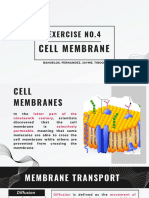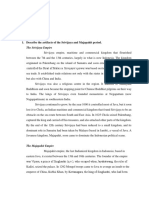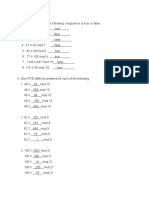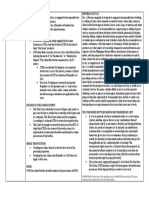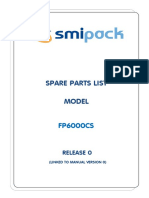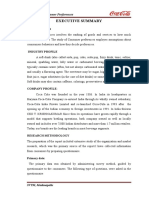Stoichiometry - Determination of Percent by Mass of NaHCO3 in Alka Seltzer Tablets
Stoichiometry - Determination of Percent by Mass of NaHCO3 in Alka Seltzer Tablets
Uploaded by
gabbal009Copyright:
Available Formats
Stoichiometry - Determination of Percent by Mass of NaHCO3 in Alka Seltzer Tablets
Stoichiometry - Determination of Percent by Mass of NaHCO3 in Alka Seltzer Tablets
Uploaded by
gabbal009Original Title
Copyright
Available Formats
Share this document
Did you find this document useful?
Is this content inappropriate?
Copyright:
Available Formats
Stoichiometry - Determination of Percent by Mass of NaHCO3 in Alka Seltzer Tablets
Stoichiometry - Determination of Percent by Mass of NaHCO3 in Alka Seltzer Tablets
Uploaded by
gabbal009Copyright:
Available Formats
1
Lab Documentation
Student Handout
Stoichiometry---Determination of Percent by Mass of NaHCO
3
in Alka Seltzer Tablets
I. Introduction
Alka Seltzer is an over-the-counter antacid and pain relief medication that is taken by dissolving it in water
before ingesting. Alka Seltzer is an effervescent tablet that contains aspirin (acetylsalicylic acid), citric acid, and
NaHCO
3
. As soon as the tablet dissolves in water, an acid-base reaction involving sodium bicarbonate takes
place. The generation of carbon dioxide from the acid-base reaction causes the bubbling. The release of carbon
dioxide into the atmosphere results in a total weight loss after the reaction. With the weight loss, one should be
able to calculate the amount of sodium bicarbonate reacted, and determine the percent by mass of NaHCO
3
contained in Alka Seltzer tablets. According to the balanced chemical equation, it takes one mole of NaHCO
3
to
produce one mole of CO
2
. In other words, the moles of NaHCO
3
reacted equals the moles of CO
2
produced.
Therefore,
mass of NaHCO
3
reacted =
(mass of CO
2
generated / M.W. of CO
2
) M.W. of NaHCO
3
percent by mass of the reacted NaHCO
3
in a tablet =
(mass of NaHCO
3
reacted in a tablet / mass of a tablet) 100 %
II. Materials and Equipment
8 (or more) Alka Seltzer Tablets (Bayer Corporation)
Vinegar (acetic acid ca. 4.5 %), 150 mL
Clear plastic cup (9 cm depth, ca. 230 mL) or a 250 mL beaker
Electronic balance (0.01g)
Graduated cylinder (50 0.5 mL). To improve the results for the early runs one might use a 10 mL
graduated cylinder.
2
III. Experimental Procedure
add 35 mL of water to a clear plastic cup
weigh and record the total weight of the cup with water in it
weigh and record the weight of an Alka Seltzer tablet
drop the tablet into the cup, carefully swirl the cup to ensure complete dissolution of the tablet
weigh and record the weight of the cup containing water and the dissolved substances when the bubbling
ceases
wash and rinse the cup with water
calculate the mass of carbon dioxide generated
calculate the mass of NaHCO
3
reacted
calculate the percent by mass of the reacted NaHCO
3
in the tablet
repeat the experiments with 5 mL vinegar + 30 mL water, 10 mL vinegar + 25 mL water, 15 mL vinegar +
20 mL water, 20 mL vinegar + 15 mL water, 25 mL vinegar + 10 mL, 30 mL vinegar + 5 mL water, and 35
mL vinegar instead of 35 mL of water
Plot the calculated % by mass of the reacted NaHCO
3
in a tablet versus the volume of vinegar used
IV. Safety and Hazards
One should not eat or taste the vinegar and Alka Seltzer tablets supplied by the instructor, even though
they are edible. Eye protection is needed for potential eye hazards from the spattering of the reaction mixture.
All solutions can be diluted with water and disposed of down the sink after the experiment.
V. Table of Data
Experiment No. Run #1 Run #2 Run #3 Run #4 Run #5 Run #6 Run #7 Run #8
Volume of Vinegar
(mL) 0 5 10 15 20 25 30 35
Volume of Water
(mL) 35 30 25 20 15 10 5 0
3
Weight of cup
with liquid
(g)
Weight of Alka
Seltzer tablet
(g)
Weight of cup
with all substances
(g)
Weight loss
(mass of CO
2
)
(g)
Calculated mass
of NaHCO
3
reacted (g)
Calculated % by
mass of the
reacted NaHCO
3
in a tablet
VI. Plot of the percent by mass of the reacted NaHCO
3
in a tablet versus the volume of vinegar used
Use Microsoft Excel to plot the percent by mass of the reacted NaHCO
3
in a tablet versus the volume of
vinegar used.
4
VII. Questions
1. Write the chemical equation corresponding to the reaction that causes the bubbling when an Alka Seltzer
tablet is dropped into water.
2. How do you determine the amount of carbon dioxide generated in the reaction?
3. How do you determine the amount of NaHCO
3
consumed in the reaction?
4. How do you completely neutralize the NaHCO
3
in the reaction?
5. How do you determine the percent by mass of NaHCO
3
in an Alka Seltzer tablet?
6. How do you interpret the graph obtained in terms of the concepts of limiting reactant?
7. How does the dissolving of CO
2
in the reaction solution and the evaporation of water affect the result of the
analysis, respectively?
Notes for the Teacher
I. Background
This experiment gives students experience with a simple chemical reaction involving materials used in
everyday life. In the process of solving a real problem, students get the opportunity to verify the concepts of
stoichiometry learned in a general chemistry class. In this laboratory, student should run the reaction, measure
the amount of the product, calculate the amount of reactant consumed according to the mole-mass relationship,
plot the experimental data, and finally, correlate the graph obtained to the behavior of limiting reactant in the
reaction.
II. Materials
All materials used (Alka Seltzer tablets, vinegar, and cocktail cups) are household materials that can be
purchased from drug stores or supermarkets.
III. Teaching Tips
1. Since the quantity of vinegar is not required in the calculation, the content of acetic acid in vinegar is not
crucial. However, vinegar with a lower concentration will result in a later switch of the limiting reactant
5
from the acid (H
+
) to NaHCO
3
and vice versa.
2. To improve the results for the early runs one might use a 10 mL graduated cylinder for the measurement of
vinegar.
3. The spattering of reaction mixture resulting from the bubbling of CO
2
during the reaction may cause an
extra weight loss. Therefore, the use of a tall type cup (or beaker) with volume around 250 mL is
suggested.
4. The cup containing reaction mixture is swirled during the experiment to ensure thorough mixing of the
reaction mixture and complete release of the gas product (CO
2
).
5. For a 10 min reaction period, there is a 35~70 mg of weight decrease in the blank vinegar-water solution
depending on the temperature and the humidity in the room. The quantity of CO
2
dissolved in 35 mL of
reaction solution is approximately 46 mg (1). While the evaporation of water leads to too large a value of
percent by mass of NaHCO
3
, the dissolving of CO
2
in solution will affect the result in the opposite way.
Therefore, the combination of the two errors should only give a minimal effect on both the shape of the
curve in the graph and the percent by mass of the NaHCO
3
.
6. Since HCl solutions have been used in the analysis of NaHCO
3
in Alka Seltzer tablets (1), it is interesting
to use HCl solution instead of vinegar in this experiment. However, the instructor should carefully decide
the concentration of the HCl solution to be used. The use of HCl solution with too high a concentration
will result in a very early switch of the limiting reactant from the acid to NaHCO
3
. The analysis of
NaHCO
3
in the tablet may not be affected by the high concentration of HCl solution, but the goal of
observing the actions of limiting reactant will not be achieved. HCl solution with concentration ranging
from 0.3 to 0.5 M is considered to be appropriate in this experiment.
7. Citric acid is one of the components of the Alka Seltzer tablet. Unlike HCl and acetic acid, citric acid is a
triprotic acid. It is interesting to use citric acid in the analysis instead of vinegar. However, the buffer
capacity of citric acid is considered to be an important factor on the resulting percent by mass of NaHCO
3
.
Since there will be a large amount of solid dissolving in water, it is important to make sure all of the tablet
is completely dissolved.
8. The reaction mixture can be diluted with water and disposed of down the sink.
IV. Answers to the Questions
6
1. HCO
3
(aq)
+ H
+
(aq)
H
2
O
(l)
+ CO
2 (g)
2. Since the gas product (CO
2
) is released into the atmosphere, the weight loss of the reaction mixture after
the reaction is the amount of CO
2
generated in the reaction.
3. According to the balanced chemical equation, it takes one mole of NaHCO
3
to produce one mole of CO
2
.
Therefore,
mass of NaHCO
3
reacted =
(mass of CO
2
generated / M.W. of CO
2
) M.W. of NaHCO
3
4. Excess acid is required to consume all the NaHCO
3
contained in Alka Seltzer tablets.
5. percent by mass of NaHCO
3
in a tablet =
(mass of NaHCO
3
contained in a tablet / mass of a tablet) 100 %
6. When NaHCO
3
is in excess, the acid (H
+
) in the reaction is the limiting reactant. As the amount of vinegar
is increased, more sodium bicarbonate will react and more CO
2
will be produced. On the other hand,
when the acid is in excess, sodium bicarbonate becomes the limiting reactant. Since the amount of sodium
bicarbonate in a tablet is fixed, the amount of CO
2
generated remains constant regardless of the quantity of
vinegar added.
7. The dissolving of CO
2
in reaction solution will lead to too small a value of percent by mass of NaHCO
3
in
Alka Seltzer tablets. The evaporation of water will lead to too large a value of percent by mass of
NaHCO
3
in Alka Seltzer tablets. The evaporation of water may be corrected by subtracting the weight loss
of a blank solution from the weight loss of the reaction. The quantity of dissolved CO
2
can be estimated
by the information used in published articles: 10 mL 6M HCl solution absorbs about 3.0 10
-4
mol of CO
2
(2). This value should be added to the weight loss obtained.
V. References:
1. Peck, L.; Irgolic, K. and O'Connor, R. J. Chem. Educ. 1980, 57, 517.
2. Dudek, E. J. Chem. Educ. 1991, 68, 948.
You might also like
- Zero FreesampleDocument10 pagesZero Freesampleroberfg99No ratings yet
- Exercise No.4: Cell MembraneDocument28 pagesExercise No.4: Cell MembraneconnievelardeNo ratings yet
- Carbonated BeverageDocument26 pagesCarbonated BeverageBhavyata VermaNo ratings yet
- Dr. Teodora Tiglao Mother of Philippine Public HealthDocument4 pagesDr. Teodora Tiglao Mother of Philippine Public HealthJamie CastilloNo ratings yet
- Blast Info SheetDocument10 pagesBlast Info SheetCatalin BaicanNo ratings yet
- Assignment 4 The CellDocument13 pagesAssignment 4 The CellTinNo ratings yet
- Exercise 1 - MicrosDocument5 pagesExercise 1 - MicrosTeya BautistaNo ratings yet
- Biome Survival Activity AssignmentDocument3 pagesBiome Survival Activity AssignmentDenialAlfonsoNo ratings yet
- Economic Analysis of Climate Change Adaptation Options in Honda Bay, Puerto Princesa, PhilippinesDocument59 pagesEconomic Analysis of Climate Change Adaptation Options in Honda Bay, Puerto Princesa, PhilippinesVicente Jr. BallonoNo ratings yet
- Lesson 8: Contemporary WorldDocument5 pagesLesson 8: Contemporary Worldkenchan smithNo ratings yet
- Amino Acid Titration. Sci PaperDocument5 pagesAmino Acid Titration. Sci PaperLiam Jacque LapuzNo ratings yet
- Chem 20 Lab Experiment 8 Fats and Oils Soaps and DetergentsDocument4 pagesChem 20 Lab Experiment 8 Fats and Oils Soaps and DetergentsChristine MarcellanaNo ratings yet
- Practice 2 Writing Effective Paragraphs: A. Read The Paragraph Above and Answer The Following QuestionsDocument3 pagesPractice 2 Writing Effective Paragraphs: A. Read The Paragraph Above and Answer The Following QuestionsRuthchell CiriacoNo ratings yet
- Alajar - Act2 - Biol 015Document4 pagesAlajar - Act2 - Biol 015jarrettrayke14No ratings yet
- 4 PROBABILITY IN GENETICS - PAZ - N2ArDocument6 pages4 PROBABILITY IN GENETICS - PAZ - N2ArChristine PazNo ratings yet
- Life and Works of RizalDocument1 pageLife and Works of RizalNin ArchiveNo ratings yet
- Activity Sheet: Rubrics For Reflection Paper Score 10 8 6 4Document3 pagesActivity Sheet: Rubrics For Reflection Paper Score 10 8 6 4hannah manuelNo ratings yet
- The Weaknesses of Filipino CharacterDocument3 pagesThe Weaknesses of Filipino CharacterJenny LopezNo ratings yet
- AC Expt 8 - Determination of The Total Alkaline Strength of Pearl Ash PDFDocument3 pagesAC Expt 8 - Determination of The Total Alkaline Strength of Pearl Ash PDFJonella Mae ChanNo ratings yet
- PIC Lab Exp#02 - Analysis of Group II CationsDocument3 pagesPIC Lab Exp#02 - Analysis of Group II CationsNight RaveNo ratings yet
- Group 3 Documentation Report Nucleic AcidsDocument5 pagesGroup 3 Documentation Report Nucleic AcidsKianna BatiancilaNo ratings yet
- Fundamentals of Business AnalyticsDocument5 pagesFundamentals of Business AnalyticsChristine Joyce Magote100% (1)
- Reinforcement Activity #3 Cracks in The Revolution 2Document4 pagesReinforcement Activity #3 Cracks in The Revolution 2Glenn CanadaNo ratings yet
- BIO 190 - Lab Activity 1 BASIC LAB TOOLS AND MICROSDocument9 pagesBIO 190 - Lab Activity 1 BASIC LAB TOOLS AND MICROSQuiane HannahniahNo ratings yet
- Describe The Artifacts of The Srivijaya and Majapahit PeriodDocument6 pagesDescribe The Artifacts of The Srivijaya and Majapahit PeriodSheryllNo ratings yet
- RizalDocument29 pagesRizalJollibeth GanteNo ratings yet
- Finals 2nd Quiz Biochem MALANADocument3 pagesFinals 2nd Quiz Biochem MALANAJay-Ar MalanaNo ratings yet
- Writing Report Science and Technology in Nation BuildingDocument11 pagesWriting Report Science and Technology in Nation BuildingissanNo ratings yet
- Fisheries Situation Report, April To June 2021 - 0Document27 pagesFisheries Situation Report, April To June 2021 - 0Jack Robert LabradorNo ratings yet
- Housekeeping 1 (Guestroom Cleaning) Module Materials List of ModulesDocument10 pagesHousekeeping 1 (Guestroom Cleaning) Module Materials List of ModulesNikki Jean HonaNo ratings yet
- Activity On The Pursuit of NationhoodDocument2 pagesActivity On The Pursuit of NationhoodVixen Aaron EnriquezNo ratings yet
- A La Juventud FilipinaDocument1 pageA La Juventud FilipinaSamuel ArgoteNo ratings yet
- 222L S11 Experiment 2 - Spectrophotometric IronDocument8 pages222L S11 Experiment 2 - Spectrophotometric IronRoberto TorrezNo ratings yet
- Science Is Systematic Study of Nature and How It Affects Us and Our EnvironmentDocument5 pagesScience Is Systematic Study of Nature and How It Affects Us and Our EnvironmentGoh Hwei SiongNo ratings yet
- Lesson 1Document4 pagesLesson 1ecaaNo ratings yet
- MMW Assignment 3.1Document1 pageMMW Assignment 3.1WeStan LegendsNo ratings yet
- Activity 2 - Evolution by Means of Natural SelectionDocument30 pagesActivity 2 - Evolution by Means of Natural SelectionMy Roses Are RosèNo ratings yet
- DWCV Grade School ChoirDocument27 pagesDWCV Grade School ChoirBhobot RiveraNo ratings yet
- Narrative Report Lab 1 4Document9 pagesNarrative Report Lab 1 4Uriel Marie JabaoNo ratings yet
- Little Known Facts On Rizal As An AgriculturistDocument4 pagesLittle Known Facts On Rizal As An AgriculturistZephaMarieCaalimNo ratings yet
- Activity ParadigmDocument4 pagesActivity ParadigmVee YaNo ratings yet
- Mathematics in The Modern WorldDocument6 pagesMathematics in The Modern WorldAllyanaMarieSantosNo ratings yet
- 2 - Rizal's Education in The PhilippinesDocument42 pages2 - Rizal's Education in The PhilippinesSamantha Angit100% (1)
- GEC 06 Art Appreciation Module 5Document21 pagesGEC 06 Art Appreciation Module 5Abigail BeltranNo ratings yet
- Bio 120 Ex 3Document2 pagesBio 120 Ex 3piiish100% (6)
- Clariza ACEBES - Narrative Report 3rd RotationDocument6 pagesClariza ACEBES - Narrative Report 3rd RotationJung Soo Mi100% (1)
- Starch As Indirect Evidence of PhotosynthesisDocument10 pagesStarch As Indirect Evidence of PhotosynthesisEstherErickaGonzalesNo ratings yet
- NSTP 2 Week 3 ModuleDocument5 pagesNSTP 2 Week 3 ModuleJason RecanaNo ratings yet
- Morality ExamDocument2 pagesMorality ExamAndy Bejerano BaidNo ratings yet
- Biolab 22 Report DialysisDocument16 pagesBiolab 22 Report DialysisTaggart Siao100% (1)
- Puno Gelitphy36Document1 pagePuno Gelitphy36Francis PunoNo ratings yet
- Amd Talk Show Script - 10 HopeDocument3 pagesAmd Talk Show Script - 10 HopeKassandra Alexa GustiloNo ratings yet
- Review Quiz 5Document3 pagesReview Quiz 5ENIDNo ratings yet
- TT2 Participant's Guidebook ManuscriptDocument216 pagesTT2 Participant's Guidebook ManuscriptCharlene Mae de leonNo ratings yet
- LYMPHDocument9 pagesLYMPHAnna AmonoyNo ratings yet
- MMW Assignment 4.2Document2 pagesMMW Assignment 4.2WeStan LegendsNo ratings yet
- ScienceDocument4 pagesScienceJay MadridanoNo ratings yet
- Cedrix James Estoquia - OLLC Lesson 4.6 Presentation and Interpretation of Data ApplicationDocument4 pagesCedrix James Estoquia - OLLC Lesson 4.6 Presentation and Interpretation of Data ApplicationDeuK WRNo ratings yet
- Critique Tulungatung (Yeo)Document37 pagesCritique Tulungatung (Yeo)YEO, REGGIE ALBERT A.No ratings yet
- The politics of hunger: Protest, poverty and policy in England, <i>c.</i> 1750–<i>c.</i> 1840From EverandThe politics of hunger: Protest, poverty and policy in England, <i>c.</i> 1750–<i>c.</i> 1840No ratings yet
- My Life Journey Through . . . with God: Reality and Facts of Life!From EverandMy Life Journey Through . . . with God: Reality and Facts of Life!No ratings yet
- 161 Alkaseltzer HPDocument3 pages161 Alkaseltzer HPiliketkstuff2No ratings yet
- Kami ExportDocument4 pagesKami Exporth.kattula278No ratings yet
- Part 2Document66 pagesPart 2Saumya mNo ratings yet
- English ProjectDocument11 pagesEnglish ProjectAanshNo ratings yet
- History of BeveragesDocument9 pagesHistory of BeveragesKamlenduNo ratings yet
- Distilleria Washington Vs La TondenaDocument1 pageDistilleria Washington Vs La TondenaCalebNo ratings yet
- FP6000CS 0 SpareDocument139 pagesFP6000CS 0 SpareferprissNo ratings yet
- Beverage & Snack Low - Zero Calorie in IndonesiaDocument11 pagesBeverage & Snack Low - Zero Calorie in IndonesiaSugitoNo ratings yet
- Imbibe LowABVCocktailsDocument9 pagesImbibe LowABVCocktailsOtavio MassanobuNo ratings yet
- Coca Cola and Carbonated BeveragesDocument7 pagesCoca Cola and Carbonated BeveragesAndry PrasetyaNo ratings yet
- Analysis of Water Sample Collected From Various Locations of Integral University, LucknowDocument39 pagesAnalysis of Water Sample Collected From Various Locations of Integral University, LucknowShrikant ShuklaNo ratings yet
- Fdocuments - in Soft DrinkDocument39 pagesFdocuments - in Soft DrinkVinayak JethaliyaNo ratings yet
- Tea and CoffeDocument33 pagesTea and CoffeNiraj Gc100% (1)
- Informational Passages RC - Soda PopDocument1 pageInformational Passages RC - Soda PopandreidmannnNo ratings yet
- The Canadian Soft Drink IndustryDocument36 pagesThe Canadian Soft Drink Industryravi_nyseNo ratings yet
- DISTILLERIA WASHINGTON V CADocument2 pagesDISTILLERIA WASHINGTON V CAJake Castañeda100% (2)
- D. Lately C. So Standing Have Saved: S + Would Rather + Have + (Verb in Past Participle)Document24 pagesD. Lately C. So Standing Have Saved: S + Would Rather + Have + (Verb in Past Participle)lee_hair_1No ratings yet
- Carnival Chula Vista Weekly AdDocument6 pagesCarnival Chula Vista Weekly AdDaniel SimaanNo ratings yet
- 9.21 - Pivot Table Slicer & Chart DashboardDocument78 pages9.21 - Pivot Table Slicer & Chart DashboardEsteban FuentesNo ratings yet
- Trends I: Getting Sparkling: A New Strategy For InnovationDocument9 pagesTrends I: Getting Sparkling: A New Strategy For InnovationsanNo ratings yet
- Advertisement Effectiveness of Cold Drinks Abhimanyu SoodDocument41 pagesAdvertisement Effectiveness of Cold Drinks Abhimanyu Soodvirendra patidarNo ratings yet
- Report SpritzerDocument12 pagesReport SpritzerSyafiq MazlanNo ratings yet
- Mohun MakinsDocument101 pagesMohun MakinsDeepak SinghNo ratings yet
- Executive SummaryDocument4 pagesExecutive SummaryAnonymous 22GBLsme10% (1)
- Vaibhav Bba 7 - 1Document37 pagesVaibhav Bba 7 - 1Marvel ShortsNo ratings yet
- Fassi Carbonated Soda Soft Drink PlantDocument2 pagesFassi Carbonated Soda Soft Drink Plantconnect2rahul4204No ratings yet
- Soft Drink: Navigation SearchDocument18 pagesSoft Drink: Navigation SearchSidra KhanNo ratings yet
- Cocktailtopic 130714132815 Phpapp01Document74 pagesCocktailtopic 130714132815 Phpapp01ponavnitNo ratings yet

